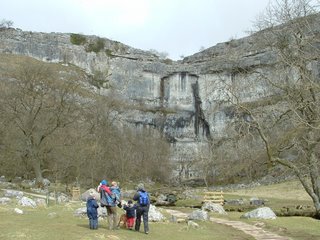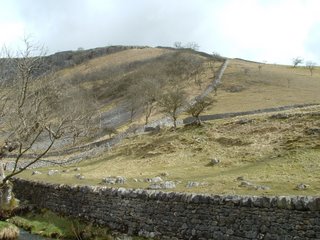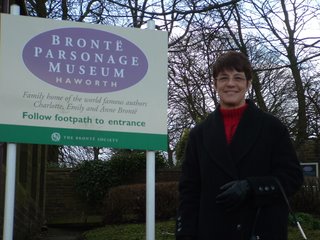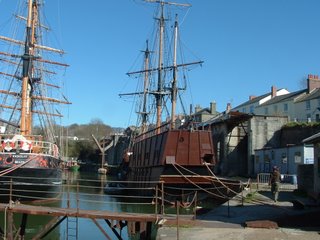



Bolton Abbey gives it's name to a pretty hamlet which is the home of the Duke of Devonshire. The remains of a 12th century Priory Church are the ccentrepiece of a beautiful piece of countryside and the river Wharfe which winds throughout. Pictures immediately above.As seems to be the norm, the Priory was partially demolished in the reign of Hentry VIII but some parts were saved, and ultimately a place of worship continued and has been used for over 800 years. Carol bought me a new Pommie cap from the shop here - very smart.
We then drove through some lovely country lanes and ended up at Grassington where we managed to park the car in one of the narrow streets. Carol had a local paper and saw an advertisment for the local b utcher selling Yorkshire beef - so of course we had to find his shop and inspect the goods. The steak looked great, so we bought two sirloins to have that night. I also bought a pork pie to supplement my packaged Ploughmans lunch, and it was the bst pork pie I have ever tasted.
Next was a visit to Fountains Abbey a National Trust site. In the 12th century a group of dissident Benedictine monks left York wishing to pursue a life of greater austerity! They were led to a wild wasteland in the narrow valley of the River Skell. After much hardship considerable wealth was provided by great Northern families and the Fountains became one of the most powerful religious houses in the north of England.
Subsequently the abbey and all it's possessions were surrendered to the King and the place fell into disrepair - a familiar story.But the National Trust have maintained the Studley Royal Water Garden which is a pleasant walk from the old ruins, and presents a delightful setting of formal lakes with classical statues and temples in the surrounding gardens. And so home to our steaks which were superb.
The last day involved driving to Malham and after driving up Malham Tarn - a narrow road up to the top at 370 metres- we parked the car and walked to Malham Cover. This cove is a limestone cliff face which originally was a mighty waterfall. On the way to the site we stopped at a group of bird watchers, who, complete with telescopes, were inviting people to observe birds. Out of eyesight, but caught by the telescope we saw a small owl happily resting in a tree and then a magnificent Kestrel sitting on a rock oblivious to the observation. The top photos sow the Cove and the surrounding hillside with the everpresent stone walls.
We drove home through miles of stone fences and fields with dozens of sheep and newborn lambs and stopped at Settle to have lunch at the Royal Hotel - a lovely old hotel which served excellent salads at a most reasonable price.










